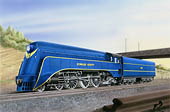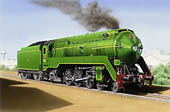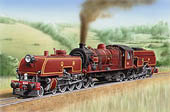
The process of creating locomotive art begins with the collection of a considerable amount of reference material, since no single photograph will show all of the desired detail. Sometimes the only reference images are in fact grainy or faded old black & white photographs (or copies of such photos).
A particular image is then selected, based on viewing angle and other aesthetic criteria, as the basis for the artwork. This is then carefully translated into a drawing, where any missing and/or obscured parts are filled in with the aid of whatever other reference images are available.
The completed primary drawing is then carefully (and very lightly) traced onto the airbrushing board (essentially being redrawn), making sure that the traced lines will not show through the translucent inks used for airbrushing.
The next stage is all about adding the colours. This usually begins with the main feature, the locomotive. I tend to use a variety of acrylic paints and airbrushing inks to add colour. I will essentially use whatever media gets the job done with the desired result.
Sections are masked off (covered) and exposed sections are airbrushed (sprayed with ink or paint). The masks or stencils are cut with a surgical scalpel, so the defining resolution and potential accuracy is the thickness of the pointy end of a scalpel blade.
The masking and painting process is then repeated until the locomotive is complete. Extra fine detail will then be added, often with a fine (and trimmed) 000 brush, a 0.18mm drafting pen or scalpel blade (used to add high lights by lightly scratching away minute amounts of paint).
The background is generally left until last, and may be a combination of airbrush and painting styles like watercolour, depending on the desired effect. The background detail is often deliberately muted to highlight our hero, the locomotive.
One of the interesting quirks of successful airbrushing, is being able to maintain a mental picture of the desired outcome, particularly the lighting and colour balance. This is because while the painting is a "work in progress" and masked, you rarely see more than one section (and colour) at a time. Another interesting twist, is that by the time the painting is finished, it has essentially been drawn at least three times. One tends to develop a rather intimate association with even the smallest details.
The complete work can easily run to over 200 hours, to produce a painting or rendering small enough that will fit comfortably within an A4 page. The whole process requires intense concentration to avoid mistakes and/or "accidents".
Unlike oil painting and some other mediums (where one can repaint or paint over sections), with airbrushing there is virtually no room for error. If you mess up an airbrushing ... most often, you will have to start again!
I know ... you'd have to be nuts, right? ;-))
A series of larger works, each anticipated to take a month or more, are currently in the planning stage.
- Peter Nowak




